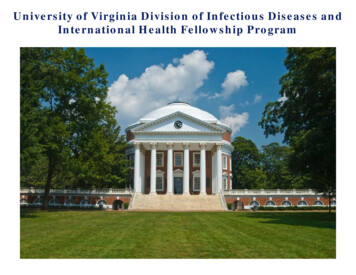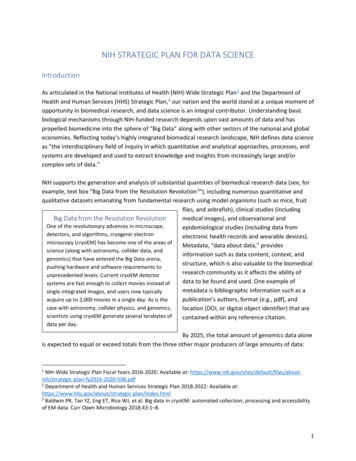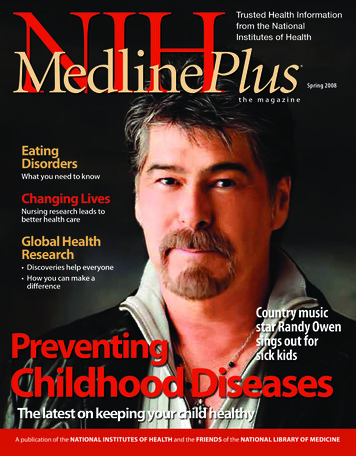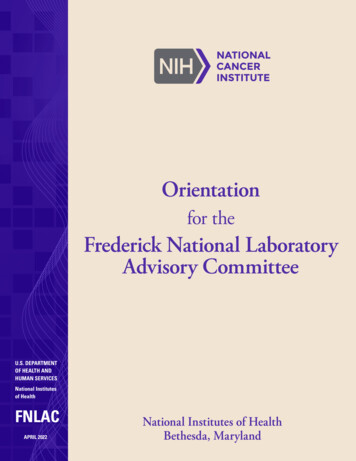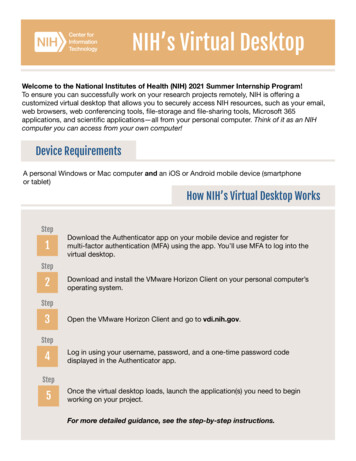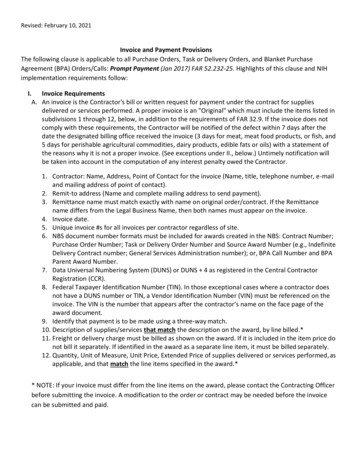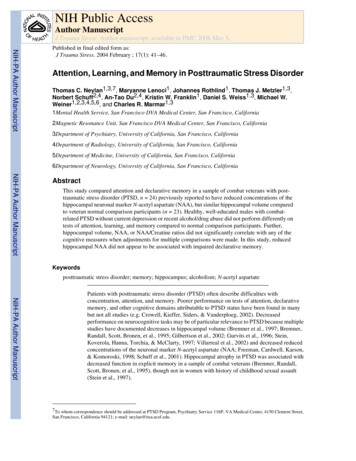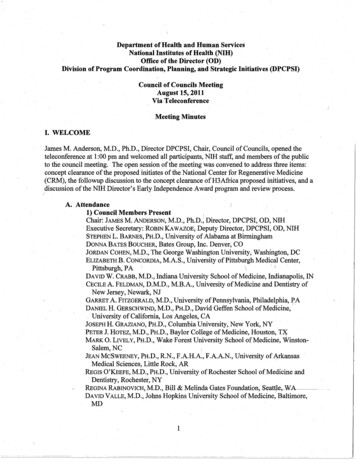
Transcription
Department of Health and Humap ServicesNational Institutes of Health (NIH)Office of the Director (OD)Division of Program Coordination, Planning, and Strategic Initiatives (DPCPSI)Council of Councils MeetingAugust 15, 2011Via TeleconferenceMeeting MinutesI. WELCOMEJames M. Anderson, M.D., Ph.D., Director DPCPSI, Chair, Council of Councils, opened theteleconference at 1:00 pm and welcomed all participants, NIH staff, and members of the publicto tlie council meeting. The open session ofthe meeting was convened to address three items:concept clearance of the proposed initiates of the Natiol).al Center for Regenerative Medicine(CRM), the followup discussion to the concept clearance ofH3Africa proposed initiatives, and adiscussion of the NIH Director's Early Independence Award program and review process.A. Attendance1) Council Members Present.Chait: JAMES M. ANDERSON, M.D., Ph.D., Director, DPCPSI; OD, NIHExecutive Secretary: ROBIN KAWAZOE, Deputy Director, DPCPSI, OD, NIHSTEPHEN L. BARNES, PH.D., University of Alabama at BirminghamDONNA BATES BOUCHER, Bates Group, Inc. Denver, COJORDAN COHEN, M.D., The George Washington University, Washington, DCELIZABETH B. CONCORDIA, M.A.S., University of Pittsburgh Medical Center,Pittsburgh, PA\'JDAVID W. CRABB, M.D., Indiana University School of Medicine, Indianapolis, INCECILE A. FELDMAN, D.M.D., M.B.A., University of Medicine and Dentistry ofNew Jersey, Newark, NJGARRET A. FITZGERALD, M.D., University of Pennsylvania, Philadelphia, PADANIEL H. GERSCHWIND, M.D., PH.D., David Geffen School of Medicine,University of California, Los Angeles, CAJOSEPH H. GRAZIANO, PH.D., Columbia University, New York, NYPETER J. HOTEZ, M.D., PH.D., Baylor College of Medicine, Houston, T MARK O. LIVELY, PRD., Wake Forest University School of Medicine, Winston Salem, NCJEAN MCSWEENEY, PH.D.,R.N., F.A.H.A., F.A.A.N., University of ArkansasMedical Sciences, Little Rock, ARREGIS O'KEEFE, M.D., PH.D., University of Rochester School of Medicine andDentistry, Rochester, NYREGINA RABINOVICH; M.D., Bill & Melinda Gates Foundation, Seatt,le,-WA - DAVID VALLE, M.D., Johns Hopkins University School of Medicine; Baltimore,MDII1
JOHN W. WALSH, Alpha-1 Foundation, Miami, FLGARY L. WESTBROOK, M.D., Oregon Health and Science University, Portland,ORTERRIE Fox WETLE, PH.D., Brown University Medical School,Providence, RILUTHER WILLIAMS,PH.D., Tuskegee University, Tuskegee, ALMARINA E. WOLF, PH.D., Rosalind Franklin University of Medicine ahd Science,North Chicago, IL2)·Council Members AbsentENRIQUETA C.BOND, PH.D., Burroughs-Wellcome Fund, Research Triangle Park,NCRICHARDL. EHMAN; M.D., Mayo Clinic College of Medicine, Rochester, MNJACKA. ELIAS, M.D., Yale University School of Medicine, New Haveo, CTEDWIN FLORES, PH.D., J.D., Chalker Flores, LLP, Dallas, TXMAE O. GORDON, PH.D., Washington University School ofMedicine,St. Louis,MOHERBERTKIMLYERLY,M.D., Duke University Medical Center, Durham, NCJUANITA L. MERCHANT, M.D., PH.D., University of Michigan, Ann Arbor, MI"3) Ad Hoc RepresentativesELIZABETH L. WILDER, PH.D., Director, Office of Strategic Coordination,DP(2PSI,OD\ 4)Presenters in Attendance. STORY LANDIS, PH.D., Director, National Institute of Neurological Disorders andStrokeMARK GUYER, PH.D., Director, Division of Extramural Research, NationalHuman Genome Research Institute and Co-Chair, Common Fund H3AfricaWorking GroupELIZABETH L. WILDER, PH.D., Director, Office of Strategic Coordination,\ DPCPSI,OD5) NIH Staff and GuestsIIi addition to Council members and presenters" others in attendance includedNIH staff aIld interested members of the public.B. Introductions and AnnouncementsRobin Kawazoe, Executive Secretary of the Council, completed a roll call, and reviewedthe following topics:Each Council member has completed and submitted a conflict of interest statementas part of the Federal requirement for membership on individual IC advisorycouncils.A summary of both the June 29, 2011, and this meeting will be posted on theDPCPSI website at http://dpcpsLnih.gov.------
Members of the public are free to submit comments after the meeting through thewebsite.II. CONCEPT CLEARANCE: NATIONAL CENTER FOR REGENERATIVEMEDICINE - PROPOSED INITIATIVESStory Landis, Ph.D., Director, National Institute of Neurological Disorders and Stroke, statedthat the study and development of stem cell technology was set as a priority by Dr. FrancisCollins shortly after his appointment as the Director of the NIH. Stem cell technology, includingthe development of induced pluripotent (iPS) stem cells, holds the potential to transformmedicine and the treatment ofpatients In January 2010, a workshop was convened to explorepotential avenues that utilize the unique resources of the NIH to develop iPS stem celltechnology and enable further progress. This meeting led to the development of the NationalCenter for Regenerative Medicine (CRM).LThe mission of the CRM is to establish a 'hub of excellence' within the NIH for the developmentand use of iPS cells in the new1therapeuticstrategies and the treatment of patients. By leveragingthe significant resources of the NIH, includ ng the NIH Clinical Center and the NationalChemical Genomics Center (NCGC) high throughput (HT) screening facility, the CRM cancoordinate resources to facilitate collaborative projects that involve both intramUral andextramural investigators to conduct transformative stem cell research.Under the guidance of the new director, Dr. Mahendra Rao, the CRM proposes to developresources for stem cell research, including establishing cell lines and a repository to store anddistribute cells, developing controls and standards, addressing procedural and policy issuesincluding coordination with other agencies such as the Food and Drug Administration (FDA),and establishing intramural and extramural collaborative efforts. Efforts towards these goalsbegan in FYII when a director was selected and seed money for pilot intramural programs wasprovided. In FYI2, focus will be applied to the generation of iPS cells and in determining whichgenotypes will be selected for the development of iPS cells. During this time, proposals forinnovative investigator-initiated, collaborative projects will be solicited. The development ofcommunity standards and banking of iPS cells will be established in F; 13. During FYI4-I6,'policy issues will be addressed, production land distribution ofGMP-grade iPS cells will beincreased, and collaborative projects will be eS!!lblished.Through extensive collaborative efforts between NIH-centered resources including the NIHClinical Center and the NCGC HT center, intramural and extramural investigators, outsideagencies such as the FDA,and the scientific community at large, the CRM can provideexceptional resources to develop and implement the clinical use of iPS stem cell technology."- This holds the potential to produce transformative results in the treatment of disease. After thisfunding period is complete, individual ICs may fund these projects.3
Discussion Highlights:CRM and the new director may not wish to wait until FY13 to establish community standards.The CRM. will build a resource that benefits both the NIH and the greater scientific communityand will allow for investigator-initiated research to occur.Neither the CRM nor the proposed initiatives are redundant with other NIH Centers or projectsincluding the proposed National Center for the Advancing Translational ScIences (NCATS) orthe Clinical and Translational Science Awards (CTSA).It is important to support research across a broad range of diseases and projects to prevent onecell or diseas ) state from dominating the field. One approach to broad support could be todetermine the top 10 disorders and compare this list to the top translational projects that areready to move forward.Along with funding research projects and infrastructure development, the ethics of stem cellresearch should be addressed simultaneously.iPS stem cell therapy holds the potential for great benefit to limiting health disparities, forexample sickle cell anemia.I,A motion to approve the Concept as presented was passed unanimously by the Council.III. FOLLOWUP TO CONCEPT CLEARANCE DISCUSSION OF H3AFRICAPROPOSED INITIATIVESDr. Anderson provided a brief recap of the H3Africa Proposal Initiative, which had beendiscussed at the Council of Councils meeting on June 29, 2011. At that time, the Council hadvoted to approve with further clarification of the proposal, especially concerning sustainability ofthe project: On July 25, additional materials were made available to Council members anddiscussed through an online forum.cThe members were reminded that the H3Africa Project has already been approved by Dr.Collins. The role of the Council is to provide input on the proposed initiatives.Discussion Highlights:Currently, the bioinformaticslbiorepository infrastructure component ofH3Africa is UIiderdevelopment coordinately with the research component. Some Council of Council memberssuggested that it might be beneficial to delay the implementatipn of research programs until afterthe infrastructure pieces are established. In response, however, it was pointed out that, if thiswere done, it would limit the ability of the research projects to help shape and grow theinfrastructure components to meet their needs.
To obtain more information to assist in development of the infrastructure program, t he NIHissued Requests for Information (RFIs) to gather details regarding the status of bioinformaticsand biorepositories in Africa. Information provided in response to these requests demonstratedthat some collaborative efforts betWeen institutions have actually already been established tobegin the process of building the necessary informatics infrastructure. Planning grants forbiorepository developments should be considered.The concern of several members that this proj ect will consume a large portion of the CommonFund budget was addressed. It was explained that the proposed budget for H3Africa was quHesmall, as a proportion of the Common Fund. It was also noted that the Wellcome Trust is acommitted financial partner in the project. Other governmental and non-governmentalorganizations, such as Grand Challenges Canada, are also considering the possibility ofproviding resources some time in the future. There is support for building biological research)inAfrica from organizations within and outside Africa. The members stated that the newinformation answered their concerns.On the broader issue, NIH staff stated that the cost of the project is not a deciding factor tor theCouncil. It was acknowledged that these proposals are complex and may require greater depth ofinformation to be provided so Council members can make an informed decision. DPCPSI isaddressing this issue.Following their receipt of the additional materials and the clarification of the resources andinfrastructure that currently exists in regions of Africa, members of the Council expressedsupport for the project. The additional information provided by the H3Africa Working groupwas sufficient to satisfy the concerns of the Council Members, and no vote was needed for thisinformational item.( \.IV. DISCUSSION OF NIH DIRECTOR'S EARLY INDEPENDENCE AWARDPROGRAM AND REVEIW PROCESSElizabeth L. Wilder, Ph.I)., DPCPSI, stated that the NIH Director's Early Independence Award(EIA) Program was established by Dr. Collins to provide a mechanism f r exceptional, early. career scientists to proceed directly to an independent research position after graduate school(without\he need for additional training as a postdoctoral fellow. Exceptional young scientists''who are within a year f completing or have completed graduate school or a residency programare eligible for this award. Awards of 250,000 per year (direct costs) for 5 years will beprovided. In response to RF A -RM-10-019, applications were limited to two per institution, with10 awards anticipated.The initial review process included two tiers. Tier-one was a scientific review conducted byqualified experts in the field of each project. In this tier, the science came first. If selec,ted, theproposals proceeded to a second-tier review. This entailed a formal interview process where thecandidate was evaluated for maturity and feasibility of managing an independent lab.An evaluation of the EIA program by the NIH was conducted while the process was ongoing.Overall, this award mechanism met with mixed responses. During this process, severalchallenges and preliminary findings were highlighted. Reviewers felt the two-tier process5
worked well, although they sought clarification on how to weigh institutional support and lettersof reference in rating the proposals. Most junior scientists who applied were currently in post doctoral fellowship or junior faculty positions and applications were tied to the currentinstitution. Although it was thought that institutions would like this award mechanism and coulduse it as a recruitment vehicle, institutions expressed difficulty understanding the eligibilityrequirement of the applicants. There was also difficulty integrating potential candidate intoexisting positions within the institution. Junior scientists expressed concern with the timelinefrom the release of the RF A to submission of the application. Due to challenges and lengthydelays in obtaining institutional sllpport, the application deadline was deemed too short. Thiswas al o complicated by the limitation of two applicants per institution. Applicants alsoexpressed difficulty obtaining collaborator support, generating preliminary data (although thiswas not a requirement), and understanding the requirements of the proposal. Many juniorscientists felt this award could be detrimental to their career. No clear definition of"exceptional" candidate was provided.Through the evaluation, the following re ;ommendations were made:Operationalize the qualifications of "exceptional."Increase awareness of the program and identify contacts within institutions to promote thismechanism.Create a centralized database of interested institutions.IIncrease the timeline between the release of the RFA and the application deadline.Calibrate the scores among reviewers.Provide questions to be addressed by referees to standardize letters of recommendation.Conduct tier-two interviews in a room conducive to interviews.Provide information to finalists with prep questions for the interview.Increase the number of awards.Discussion Highlights:This mechanism should be a good vehicle for institutions to recruit scitimtists.IThe review process could be simplified to a review of student past achievement and the researchplan.As awardees are selected, their profiles can be used as examples of what constitutesexceptional junior scientist.an.An indicator of "exceptionaP' is whether the individual has gone beyond the normal trajectory ofhis or her lab.
This mechanism selects for the rare individual whose research career will actually benefit frombypassing the usual postdoctoral experience. The EIA could hann individuals who are not readyfor early independence.At times, it is difficult to detennine how much influence and independence a student has fromhis or her mentor. Independence is important for this award mechanism, therefore awards tostudents who will still be highly influenced by a mentor should be avoided. How to detennine ifthis is the case prior to awarding the project is difficult. Program management by NIH can helpclarify how independent an awardee is after the establishment of the new lab.Although this is an independent award, the institution must provide a good/productiveenvironment for the new faculty member. This includes good mentorship at the institution.V. CLOSING REMARKSDr. Anderson thanked all participants and the open-session of the teleconference was adjournedat 2:30 p.m., and the closed session followed immediately thereafter.VI. CERTIFICATIONI hereby certify that, to the best of my knowledge, the foregoing summary minutes are accurateand complete.'-!\.()Jl-\\-t.".LL.JS M. ANDERSON, M.D., Ph.D. (Date). ,NIH Council of CouncilsDirector, Division of Program Coordination,Planning, and Strategic Initiatives (DPCPSI)Office of the Director (OD), NIH !/ftl#:z (Date)Executive Secretary, NIH Council of CouncilsDeputy Director, DPCPSI, OD, NIHOffice of the Director (OD), NIHdI1H.7
ELIZABETH B. CONCORDIA, M.A.S., University of Pittsburgh Medical Center, . GARY L. WESTBROOK, M.D., Oregon Health and Science University, Portland, OR TERRIE Fox WETLE, PH.D., Brown University Medical School,Providence, RI . Each Council member has completed and submitted a conflict of interest statement as part ofthe Federal requirement .
